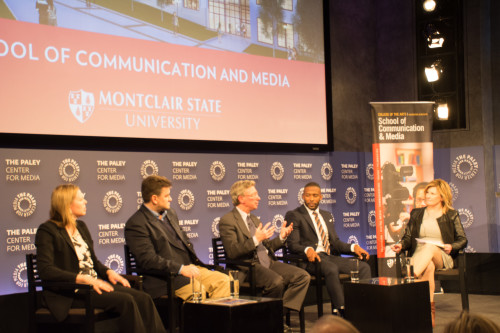
Montclair State professor, Kelly Whiteside, moderated the New York City panel. Photo credit: Frabicio Costa
Montclair State’s School of Communication and Media held their inaugural symposium on the future of sports coverage and journalism at The Paley Center for Media in New York City on Feb. 17. The event attracted around 100 guests, including Montclair State professors, students and professionals in the sports media industry.
“When I teach as an adjunct at Montclair State, I get a lot of questions from my students: ‘Professor — journalism? Is it worth it?’” said panelist and sports reporter, Harvey Araton. “I do think that the technology has created and will continue to create better ways to story-tell and reach readers.”
The panel consisted of five distinguished members of the sports sphere including Araton; moderator Kelly Whiteside, Montclair State professor and sports journalist; Felix Alvarez-Garmon, Senior Vice President of Latin America for IMG Media; Val Ackerman, Big East Conference Commissioner and former WNBA President; and Andrew Hawkins, Cleveland Browns wide receiver.
The discussion focused on where the sports media field is headed and how coverage will change, addressing more specifically the topics of audience involvement and the massive consumption of sports news by that audience.
“People want the quick hit. We have young people who don’t have as long attention spans,” said Ackerman.
Due to the constant onslaught of information tumbling down news feeds every day, consumers are forced to keep moving onward, sometimes sacrificing the deeper and more detail-oriented approaches of the past.
“I think because of the volume of information, the sheer number of stories, the number of sources and the shortened time spans, what we’re seeing is there becomes sort of a business of curation,” said Ackerman.
However, the panel iterated that there are constants that need to be upheld to create balance and power in good journalism in its ever-changing environment.
“There is a difference between doing two-letter reporting, dialing reporting or texting reporting,” said Araton. “And that’s really the difference. That’s how you separate journalism from that big, amorphous media thing.”
Hawkins also spoke in a rare and candid way about how players view social media, where they can bypass journalists and get their stories across however they want. Hawkins included an example of his self-written article for Derek Jeter’s “The Player’s Tribune.”
“Finally I could tell my story the way that I wanted to, in the words that I wanted to and express it exactly how it happened from my perspective, and it was just so liberating,” he said.
Hawkins’ presence in the discussion shed a light on how players feel about the media and are trained by their respective teams to keep distraction and controversy to an absolute minimum, making reporters’ jobs that much more difficult.
“That’s why you’ve all heard the clichés a million times,” said Hawkins. “They literally sit people [down] before the season to tell us how not to give information without anybody knowing you’re not giving them information.”
With sports news saturation at an all-time high, the panel emphasized what fans and journalists alike are and will be looking for today and in the future: an attention-grabbing headline related to one of the game’s big names.
“I’ve snapped back at media personnel, reporters or for questions that I didn’t think were good questions, and I’ve told them, ‘That’s a dumb question. Next question,’” said Hawkins. “But nobody cares if I say it, because I’m not Cam Newton.”


